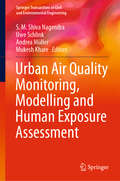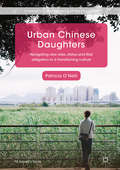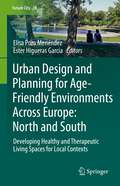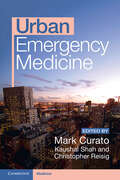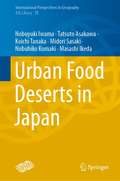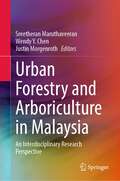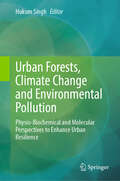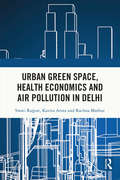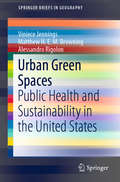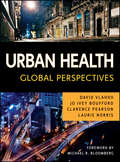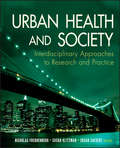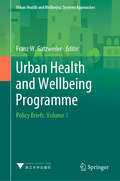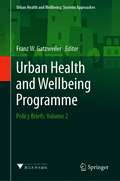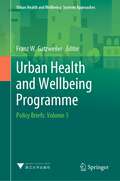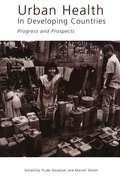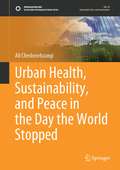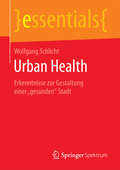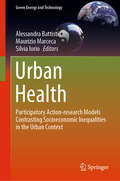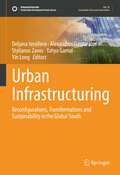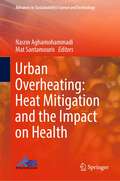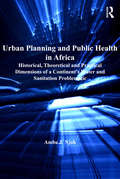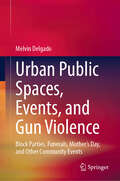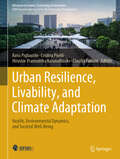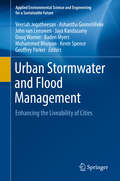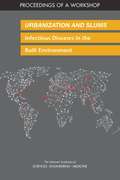- Table View
- List View
Urban Air Quality Monitoring, Modelling and Human Exposure Assessment (Springer Transactions in Civil and Environmental Engineering)
by Andrea Müller S. M. Shiva Nagendra Uwe Schlink Mukesh KhareThis contributed volume is primarily intended for graduate and professional audiences. The book provides a basic understanding of urban air quality issues, root causes for local and urban air pollution, monitoring and modelling techniques, assessment, and control options to manage air quality at local and urban scale. The book also offers useful information on indoor air quality and smart sensors, which are gaining much importance in current times.
Urban Chinese Daughters: Navigating New Roles, Status and Filial Obligation in a Transitioning Culture (St Antony's Series)
by Patricia O’NeillThe lives of urban Chinese daughters have changed. Education and employment have propelled them from dependency to self-sufficiency, resulting in new attitudes and lifestyles. However, traditional filial obligation has remained. This book asks why it continues and how it is currently discharged, focusing on the emotion work daughters do to sustain the parent relationship, deal with conflict and maintain their self-esteem.Based on interviews with women living in Hong Kong, Singapore and mainland China, the book further explores whether the structural or relational motivations underpinning support and care may be less important than the standards daughters impose on themselves; why care may be discontinued or not undertaken in the first place; why care provided to parents may be different from in-laws, and the importance of domestic helpers to the modern caregiving paradigm.To undertake this exploration, a typology of support and care was created, allowing for the first time to distinguish between what daughters do for healthy parents and in-laws versus parents who require temporary or full time care, specifically addressing how providing support and care affects the daughters’ well-being.
Urban Design and Planning for Age-Friendly Environments Across Europe: Developing Healthy and Therapeutic Living Spaces for Local Contexts (Future City #19)
by Elisa Pozo Menéndez Ester Higueras GarcíaThis book represents a multidisciplinary and international vision across different countries in Europe that are facing similar challenges about ageing and quality of life in present cities. It is divided in three main topics from the global context of health in cities and reduction of health inequities to the current research of different study cases, focusing on residential models and the relationship with the built environment. The third chapter illustrates best practices with some study cases from different cities in Europe. Friendlier environments for older people come together with the need of innovation, smart and updated technologies, healthier environments and mitigation of climate change. Health re-appears nowadays as one of the priorities for urban planning and design, not only for the communicable diseases and the effect of the pandemics, but also for the non-communicable diseases, that were also triggering the wellbeing and equity of our cities. Indeed, the Covid-19 pandemic has highlighted health inequities and vulnerabilities of those areas of the city that were already deprived and facing other health problems, such as obesity, diabetes, social isolation, respiratory problems or mental health issues, specifically applying for vulnerable groups. Older adults have been one of the most affected groups from the pandemic’s threats and derived consequences. In this context, the care crisis arises intertwined with the design and planning of our cities, where there is an urgent need to regenerate our environments with a perspective of sustainability, inclusion, and health prevention and promotion. From the global urban challenges to the specific contextualisation of each city and study cases, each chapter offers an updated insight of the main questions that we should consider to address urban planning and design from the perspective of ageing and social inclusion in European cities.
Urban Emergency Medicine
by Kaushal Shah Mark Curato Christopher ReisigExperts from the top hospitals in America's largest cities provide their insights into the disease states, injuries, patient populations, practice barriers, and societal conditions which present disproportionality in urban emergency departments. Distilling the authors' special expertise and skills in a clear and user-friendly way, this book enables the reader to recognize the impact of healthcare disparities on patient well-being and identify and manage the needs of special patient populations, including victims of substance abuse and intimate partner violence. Clinical chapters define conditions through case studies, discussing their prevalence in the urban setting, and offer expert advice for immediate and effective management. In addition, the book helpfully provides context and valuable tips for best practice and introduces new ways of thinking about the diseases and the problems discussed. Essential reading for clinicians looking to improve their knowledge of urban emergency medicine, from students through to senior attending practitioners.
Urban Food Deserts in Japan (International Perspectives in Geography #15)
by Koichi Tanaka Nobuyuki Iwama Tatsuto Asakawa Midori Sasaki Nobuhiko Komaki Masashi IkedaThis book introduces the Japanese urban food desert (FD). Currently, Japan has the most rapidly aging society in the world, with a shrinking population and food desert issues in connection with the isolation of the elderly people from their families and local communities. The types of food deserts that Japan is currently facing are likely to occur in many other countries under similar circumstances in the near future. This book serves as a valuable resource for researchers and policymakers who are working on FD issues in Japan as well as in other countries. The book consists of 8 chapters, with each chapter covering a different aspect of FD, and it also includes case studies, one of which is the FD in Tokyo.
Urban Forestry and Arboriculture in Malaysia: An Interdisciplinary Research Perspective
by Sreetheran Maruthaveeran Wendy Y. Chen Justin MorgenrothThis book represents the latest research on urban forestry in a Malaysian context. It demonstrates that urban forestry is concerned not only with environmental enhancement, but also other aspects, such as recreation, health and well-being, and government policies. This edited collection provides a comprehensive overview of urban forestry studies from various researchers in Malaysia, and includes rich historical perspectives of urban forestry in the country. It also tackles related issues in policy. The greening of urban Malaysia in the 1970s focused primarily on beautification and was primarily the province of horticulturists, landscapers, nursery workers, town planners, and architects, with negligible inputs from foresters, particularly urban foresters. Perhaps for that reason, the term “landscaping” has been used more widely than “urban forestry” by government and private institutions, politicians, stakeholders, academicians, and the public. Nevertheless, the authors show that the concept of urban forestry is not new for developing countries such as Malaysia, where urbanization is increasing at a rapid rate. The book unpacks this demographic shift from a predominantly rural to a principally urban society. As the only unified body of work on urban forestry and arboricultural studies in Malaysia, this volume presents an important interdisciplinary reference for students, researchers, and scholars in physical geography, forestry and urban forestry, arboriculture and landscape architecture, both in Malaysia, and in other developing urbanizing countries, particularly in Southeast Asia. It is also an important resource for those working in environmental policy and practice, excavating the vital connection between the environment and well-being.
Urban Forests, Climate Change and Environmental Pollution: Physio-Biochemical and Molecular Perspectives to Enhance Urban Resilience
by Hukum SinghThis book contributes significantly to the international literature by bringing forth a novel and comprehensive exploration of urban resilience in the face of climate change and environmental pollution. Its focus on integrating physiological, biochemical, and molecular dimensions distinguishes it from existing literature. The book offers several key contributions, including an interdisciplinary approach to understanding the complex interactions within urban ecosystems. It includes cutting-edge insights that have not been extensively explored in existing literature, practical applications, and evidence-based strategies to enhance urban sustainability and resilience. The book has a global relevance to a diverse international readership and provides strategic guidance to policymakers and urban planners when making decisions to develop evidence-based strategies that cater to the specific challenges of cities. Urban forests play a critical role in enhancing the resilience of cities by providing numerous benefits, including improved air quality, reduced urban heat island effect, and enhanced biodiversity, ultimately improving urban health. Besides, urban forests are a crucial natural-based solution (NbS) to mitigate air pollution and climate change impacts in cities. However, in the face of climate change and environmental pressures, urban forests face significant challenges to their survival and functionality. This book explores the complex morpho-physio-biochemical and molecular changes that enable urban forests to flourish amidst climate change and environmental pollution. It examines how urban trees modulate their morphological structures, including root systems and physiological and biochemical functioning, and molecular alterations to withstand changing urban climatic and environmental conditions.
Urban Green Space, Health Economics and Air Pollution in Delhi
by Swati Rajput Kavita Arora Rachna MathurThis book looks at the ecological stress on cities and engages with challenges of reducing vulnerabilities and risks of pollution on the health, well-being and livelihoods of people living in developing countries. Cities are the world’s highest energy consumers and the biggest producers of toxic wastes and pollutants. With an emphasis on the environmental issues facing the city of Delhi, the volume focuses on steps to preserve and manage the city’s urban green spaces. It explores the concept of urban green spaces and their economic, social, health, and psychological significance in cities. Drawing from their fieldwork and research in Delhi, the authors identify the sources of pollution in the city and access the role of urban green spaces in countering adverse effects. They further examine the relationship between green spaces and social and economic development, urban health, and urban governance. They highlight the good practices followed by other global cities. The volume also offers suggestions and policy recommendations to reverse and recover ecological balance in cities. This book will be of interest to students and researchers of environment and ecology, public health, urban planning and governance, development studies, urban geography, urban sociology, resource management and health economics. It will also be useful for policy makers, and NGOs working in the areas of sustainability, urban planning and management and environmental preservation.
Urban Green Spaces: Public Health and Sustainability in the United States (SpringerBriefs in Geography)
by Viniece Jennings Alessandro Rigolon Matthew H. BrowningThis book crosses disciplinary boundaries to investigate how the benefits of green spaces can be further incorporated in public health. In this regard, the book highlights how ecosystem services provided by green spaces affect multiple aspects of human health and well-being, offering a strategic way to conceptualize the topic. For centuries, scholars have observed the range of health benefits associated with exposure to nature. As people continue to move to urban areas, it is essential to include green spaces in cities to ensure sustained human health and well-being. Such insights can not only advance the science but also spark interdisciplinary research and help researchers creatively translate their findings into benefits for the public. The book explores this topic in the context of ‘big picture’ frameworks that enhance communication between the environmental, public health, and social sciences.
Urban Health
by Pearson David Vlahov Boufford Jo Ivey Clarence E. Laurie NorrisIn the twentieth century, the urban settings of the wealthy nations were largely associated with opportunity, accumulation of wealth, and better health than their rural counterparts. In the twenty-first century, demographic changes, globalization, and climate change are having important health consequences on wealthy nations and especially on low- and middle-income countries. The increasing concentration of poverty and significant inequalities between urban neighborhoods and the physical and social environments in cities are important determinants of population health. In this important new book, experts identify the priority problems and outline solutions that can generate and sustain healthy urban environments. Foreword by Michael H. Bloomberg Contributors include: Sue Atkinson, John G. Bartlett, Angela Beaton, Karl Brown, Pamela Ligouri Bunker, Robert J. Bunker, Scott Burris, Waleska Teixeira Caiffa, Roel A. Coutinho, Manuel Carballo, Ruth Colagiuri, Beatriz de Faria Leao, Amélia Augusta de Lima Friche, Alex Ezeh, Geoff Green, Claudio Giulliano da Costa Octavio Gómez-Dantés, Ruth Finkelstein, Julio Frenk, Nicholas Freudenberg, Fu Hua, Sandro Galea, Ticia Gerber, Carola Hein, Catherine Hull, Tord Kjellstrom, Jacob Kumaresan, Catherine Ronald Labonté, Stephen Leeder, Godfrey Mbarauku, Gordon McGranahan, Patricia Monge, Mark R. Montgomery, Martin Mulenga, Ana Luiza Nabuco, Julie Netherland, Ndioro Ndiaye, Rougui Ndiaye-Coïc, Kalala Ngalamulume, Danielle Ompad, Stipe Oreskovic, Ariel Pablos-Méndez, Jonathan Parkinson, Fernando Augusto Proietti, Thomas C. Quinn, Carlos E. Restrepo, Kevin J. Robinson, Jonathan M. Samet, David Satterthwaite, Richard H. Schneider, Ted Schrecker, Elliott Sclar, Maria Steenland, Agis Tsouros, Arnoud P. Verhoeff, Nicole Volavka-Close, Michael Ward, Vanessa Watson, Rae Zimmerman.
Urban Health and Society
by Susan Saegert Susan Freudenberg Nicholas KlitzmanPraise for Urban Health and Society "This is a spectacular resource for practitioners, policymakers, researchers, and students interested in improving the lives and health of individuals and families in urban settings. This book provides the most current frameworks, research, and approaches for understanding how unique features of the urban physical and social environments that shape the health of over half of the world's population that is already residing in large cities. Its interdisciplinary research and practice focus is a welcome innovation. " -Hortensia Amaro, associate dean, Urban Health Research; Distinguished Professor, Bouve College of Health Sciences; and director, Institute on Urban Health Research, Northeastern University "Urban Health and Society: Interdisciplinary Approaches to Research and Practice provides students in public health, urban planning, social work, and other professions with the critical knowledge and practical guidance they need to work as effective members of interdisciplinary teams aimed at studying and addressing urban health problems. Throughout the chapters, the book's attention to community participation, social justice, and equity as well as interdisciplinary research methods make it an invaluable resource. " -Barbara A. Israel, professor, Department of Health Behavior and Health Education, School of Public Health, University of Michigan "The book will be of great interest to academics, politicians, planners, and public health professionals attempting to understand or reduce urban health risks, create safe urban environments, and deliver effective and sustainable health services and programs to urban populations. " -Stephen Lepore, professor and PhD program director, Department of Public Health, Temple University
Urban Health and Wellbeing Programme: Policy Briefs: Volume 1 (Urban Health and Wellbeing)
by Franz W. GatzweilerThis book is a compilation of the policy briefs produced by the International Science Council’s program on Urban Health and Wellbeing: A Systems Approach over the past five years. Intended for urban decision-makers at all levels, it highlights policy-relevant findings and research insights to encourage the co-creation of knowledge for healthy urban environments and people. The book shows how variations on the systems approach developed and promoted by the program have been implemented in regions around the world and contributed to improving urban health. These policy briefs summarize research findings and scientific events concerning urban health-related topics that are relevant for public health professionals, urban planners, urban stakeholder groups and the public at large.
Urban Health and Wellbeing Programme: Policy Briefs: Volume 2 (Urban Health and Wellbeing)
by Franz W. GatzweilerThis book is a collection of policy briefs produced from research presented at the 16th Conference on Urban Health in Xiamen, China, November 4–8, 2019, under the theme “People Oriented Urbanisation: Transforming Cities for Health and Well-Being”, co-organized by the Urban Health and Wellbeing (UHWB) programme of the International Science Council (ISC). The UHWB programme takes an interdisciplinary, cross-sectoral and systemic view on issues of health and wellbeing in cities which include the urban economy and finance systems, education, employment, mobility and transport, food, energy and water resources, access to public services, urban planning, public spaces and urban green, as well as social inclusion. Contributions to this book have been made by scientists from multidisciplinary research fields. The policy briefs in this book present the background and context of an urban health issue, research findings and recommendations for policy/decision-makers and action-takers. In some cases, they inform about relevant events and developments from the science community or important opinion pieces which address health emergencies, like the current COVID-19 pandemic. The book is intended for citizens and political decision-makers, who are interested in systems perspectives on urban health and wellbeing, examples of how to deal with the increasing complexity of cities and the accompanying environmental and social impacts of increasing urbanization. Furthermore, it hopes to inspire decision-makers to facilitate finding solutions, in order to reach the goal of advancing global urban health and wellbeing.
Urban Health and Wellbeing Programme: Policy Briefs: Volume 3 (Urban Health and Wellbeing)
by Franz W. GatzweilerThis book presents the background and context of an urban health issue, research findings, and recommendations for policy/decision-makers and action-takers. This book is a collection of policy briefs produced from research presented at the 16th Conference on Urban Health in Xiamen, China, during November 4–8, 2019, under the theme “People Oriented Urbanisation: Transforming Cities for Health and Well-Being,” co-organized by the Urban Health and Wellbeing (UHWB) programme of the International Science Council (ISC), The 15th Annual Session of Global Forum on Human Settlements in Shenzhen, China, during October 15–16, 2020, and the Chinese Academy of Sciences & Technology (CAST) International Conference on "Digital economy and green development" held during November 2020. The UHWB programme takes an interdisciplinary, cross-sectoral, and systemic view on issues of health and well-being in cities which include the urban economy and finance systems, education, employment, mobility and transport, food, energy and water resources, access to public services, urban planning, public spaces and urban green, as well as social inclusion. Contributions to this book have been made by scientists from multidisciplinary research fields. The policy briefs in this book provide an interdisciplinary and cross-sectoral perspective on urban health and human well-being issues, primarily food security, urban infrastructure, public services, traffic and transportation, smart city building, urban health and safety, social cohesion sustainable development policies, and urban planning. In some case, it informs about urban health issues in different regions of the world, the current status, and key insights into addressing related issues, with emphasis on factual cases in the current COVID-19 pandemic. The book is intended for citizens and political decision-makers, who are interested in systems perspectives on urban health and well-being, examples of how to deal with the increasing complexity of cities and the accompanying environmental and social impacts of increasing urbanization. Furthermore, it hopes to inspire decision-makers to facilitate finding solutions, in order to reach the goal of advancing global urban health and well-being.
Urban Health in Developing Countries: Progress and Prospects (Urban Management Programme Ser. #No. 6)
by Marcel TannerThe impact of urbanization on the health of citizens in developing countries has received increasing attention recently. This book addresses the problems in an integrated way, looking in detail at both the problems themselves and the action and research necessary to alleviate them. It includes contributions from leading practitioners and advisors to many of the main international agencies and presents the latest thinking of those institutions. It also presents recent information on research findings, the management and financing of urban health services and trends in urban health policy. Case studies examine major initiatives in cities as diverse as Santiago, Dar es Salaam, Dhaka, Kampala and Bombay.
Urban Health, Sustainability, and Peace in the Day the World Stopped (Sustainable Development Goals Series)
by Ali CheshmehzangiThis book covers the nexus between urban health, sustainability, and peace. 'Urban Health, Sustainability, and Peace' is the first book that attempts to put these three critical areas together. This novelty approaches the subject matter by delving into evaluating what works, what does not work, and what should be done to achieve healthy cities. We believe this book will be beneficial to a wide range of stakeholders, particularly policymakers, planners, and developers, who continuously shape and reshape the structure and environments of our cities and communities. Unfortunately, in most cases, the healthiness of the cities may not be of their immediate concern. Nevertheless, it is the concern of the end-users, citizens, or simply those who live and work in cities and communities worldwide. To safeguard peace in cities, one has to consider sustaining urban health; and that is the main aim of this book. The ongoing pandemic gives us an excellent reason to study cities' health. During such a disruptive time, we detect many flaws in cities and communities around the world. We primarily identify the negative impacts on sustainability and peace in cities. In order to sustain a healthy city, this book evaluates six sustainability dimensions of physical, environmental, economic, social, institutional, and technical. It then utilizes eight primary dimensions of positive peace, evaluating critical areas for future considerations in urbanism. These considerations include making cities smarter, more resilient, and more sustainable. The book's ultimate goal is to highlight how we should progress to maintain and sustain urban health. As a continuation to 'The City in Need,', this book covers the nexus between urban health, sustainability, and peace. Furthermore, by reflecting on the ongoing pandemic crisis, metaphorically labelled as 'The Day the World Stopped,', we delve into some key areas beyond the usual planning and policy guidelines. Lastly, the book intends to highlight what has not been studied before, i.e., the relationship between urban health, sustainability, and peace.
Urban Health: Erkenntnisse zur Gestaltung einer „gesunden“ Stadt (essentials)
by Wolfgang SchlichtWolfgang Schlicht stellt das Forschungsgebiet Urban Health, im Deutschen auch StadtGesundheit, vor, in dem er zu Beginn einen kurzen Abriss zur Geschichte der Stadt, zu Leitbildern der Stadtgestaltung und zu Urban Health gibt. Ausgew#65533;hlte Erkenntnisse zu Stadtmerkmalen, die Gesundheit beeintr#65533;chtigen (reaktions-orientierte Perspektive), und zu solchen, die Gesundheit f#65533;rdern (promotions-orientierte Perspektive), werden referiert. Theoretische Konzepte und methodische #65533;berlegungen zur Erkenntnisgewinnung runden das essential ab.
Urban Health: Participatory Action-research Models Contrasting Socioeconomic Inequalities in the Urban Context (Green Energy and Technology)
by Alessandra Battisti Maurizio Marceca Silvia IorioThis book qualitatively and quantitatively examines the relationships between the constructed environment, health and social vulnerability. It demonstrates that spatial disintegration is often intertwined with health and social inequalities, and therefore a multidisciplinary approach to urban health is essential in order to analyze the impact that psycho-social-environmental factors can have on objective, and perceived health and to investigate the inequalities in healthcare and medical assistance processes. Empirical relationships have been observed between urban environment, social vulnerability and health in different contexts, however there is still a lack of standardized tools that allow us to gain a clear understanding of how health inequalities and daily life are generated. In order to address this issue, a national network of active research groups has been created to draft and develop a prototypical analysis infrastructure to facilitate empirical studies aimed at shedding light on the complex relationships between health disparities, socio-environmental and economic distress, as well as personal and collective health. Given the interest in achieving meaningful, fair and lasting solutions to health inequalities, and the current lack of an analytical system, there is the need for new multidisciplinary approaches oriented toward the quality of life within a eco-social model of health. Providing an overview of the methodological approaches discussed, this book will appeal to researchers. At the same time it allows those working in local and government social care, healthcare and administrative institutions to gain insights into best practices in urban contexts.
Urban Infrastructuring: Reconfigurations, Transformations and Sustainability in the Global South (Sustainable Development Goals Series)
by Alexandros Gasparatos Deljana Iossifova Stylianos Zavos Yahya Gamal Yin LongThis book is about urban infrastructuring as the processes linking infrastructural configurations and their components with other social, ecological, political, or otherwise defined systems as part of urbanisation and globalisation in the Global South. It suggests that infrastructuring is essential to urbanisation and that it is entangled with socio-spatio-ecological transformations that often have negative outcomes over time. Furthermore, it argues that infrastructuring requires an ethical positioning in research and practice in order to enhance infrastructural sustainability in the face of intersecting environmental, social and economic crises. “Urban Infrastructuring” is developed in three parts. First, it identifies infrastructural entanglements across various urban and urbanising settings in the Global South. Second, it highlights some of the damaging processes and outcomes of urban infrastructuring and argues that the absence, presence and transformation of infrastructure in the Global South (re-)produces socioecological injustice in the short- and long term. Third, the book argues for a shift of infrastructuring agendas towards more just and sustainable interventions. It suggests that an ethico-politics of care should be embedded in systems approaches to infrastructuring in both research and practice. The edited volume contains contributions from authors with backgrounds in a variety of academic disciplines from the natural and social sciences, engineering and the humanities. It provides valuable insights for anyone concerned with the study, design, planning, implementation and maintenance of urban infrastructures to enhance human well-being and sustainability. It will be of interest to researchers and urban decision-makers alike.
Urban Overheating: Heat Mitigation and the Impact on Health (Advances in Sustainability Science and Technology)
by Mat Santamouris Nasrin AghamohammadiThe book reviews and reports the recent progress and knowledge on the specific impact of current and projected urban overheating as well as of the urban mitigation technologies on mortality and morbidity and urban vulnerability. It presents recent data and developments on the topic reported by some of the more distinguished researchers in this area. In parallel, it discusses new findings related to the characteristics and the magnitude of urban overheating and reports and analyzes the recent knowledge on the synergies between urban heat island and heatwaves. This book helps to advance our understanding on the interaction between Urban Heat Island (UHI) and overheating as well as their impact on energy demand and public health globally. Exploring the interaction between UHI and energy consumption requires the understanding on the dynamics of UHI intensity and air pollution index in different land use and how such interactions may vary in different cities in the world. Moreover, this book focuses on different cities in Australia, Austria, Belgium, Brazil, Canada, Cyprus, Greece, Hong Kong, India, Asia, Spain, UK, and USA.
Urban Planning and Public Health in Africa: Historical, Theoretical and Practical Dimensions of a Continent's Water and Sanitation Problematic
by Ambe J. NjohEstablished indicators of development suggest that, as a group, African countries lag behind their counterparts in other regions with respect to public health. Particularly noteworthy is the fact that the public health problems of these countries are rooted in preventable causes associated with hygiene and sanitation. It is customary to attribute the problems that ail Africa to the lack of financial resources. This book deviates from convention by suggesting non-financial factors as the source of sanitation problems on the continent, and argues the need to re-connect urban planning to public health. These two professions are consanguine relatives and emerged to combat the negative externalities of the industrial revolution and concomitant urbanization. However, with the passage of time, the professions drifted apart. Today, more than ever, there is a need for the two to be re-connected. This need is rooted in the increasing complexity of urban problems whose resolution requires interdisciplinary initiatives. To this end, there is hardly any question that urban public health initiatives are unlikely to succeed without the collaboration of both public health and urban planning experts. The book recognizes this truism, and stands as the first major academic work to demonstrate the inextricably intertwined nature of urban planning and urban public health in Africa.
Urban Public Spaces, Events, and Gun Violence: Block Parties, Funerals, Mother's Day, and Other Community Events
by Melvin DelgadoThis book offers a new vision on urban gun violence that focuses on public space-centered concepts, events, and research. It builds on our existing knowledge base by viewing a "slice" of this problem through celebratory and solemn occasions and how violence at these events and spaces reflects on the state of urban gun violence. Understanding this context serves to inform us on how best to address this social phenomenon. Gun violence in the United States is a salient national problem with virtually no day that goes by without it occurring, particularly in urban public spaces, making it a significant social event. This book uniquely presents an urban- and event-focused context for gun violence. It also draws attention to marginalized urban communities, merging urban public spaces, events, intersectionality, social justice, and gun violence, introducing a unique window to better comprehend this violence as a national issue and bringing profound consequences when it transpires in a public event. To examine the context of public spaces and events in gun violence, the author organized the book’s ten chapters in three sections: Part I: Conceptual Foundation sets the foundation for a multifaceted perspective. Part II: Celebratory and Solemn Events expands the gun violence arena. Part III: Implications for Research, Education, and Practice. Urban Public Spaces, Events, and Gun Violence: Block Parties, Funerals, Mother’s Day, and Other Community Events expands the context of gun violence beyond the street scene to include public settings and events, and helps in achieving a comprehensive understanding of this public health problem and how best to solve it. The book is essential reading for practitioners, academics, and researchers in public health, social work, criminal justice, and community practice.
Urban Resilience, Livability, and Climate Adaptation: Health, Environmental Dynamics, and Societal Well-Being (Advances in Science, Technology & Innovation)
by Cristina Piselli Claudia Fabiani Hirushie Pramuditha Karunathilake Ilaria PigliautileThis book explores urban environments and their impact on resilience, livability, climate adaptation, health, and societal well-being. It provides interdisciplinary insights for fostering resilient, livable, and sustainable cities prioritizing well-being and quality of life for all residents. The book covers various topics and discusses innovative approaches for incorporating nature into urban planning. It also examines the relationships between diet diversity, food environments, and transportation systems. Spatial analysis of noise contour maps based on traffic speed is conducted, along with an assessment of the impact of office environments on productivity. The book explores the influence of streetscapes on anxiety, envisions future cities from a youth perspective, and identifies critical factors affecting the design and use of elevated urban spaces. Daylighting performance in school expansions is evaluated, and the concept ofa livable city is examined. Community adaptive capacity for climate-resilient development is assessed through a case study analysis. The livability of street vendors in different urban contexts is compared, and alternative perspectives on restorative environments are presented. The book investigates the impact of urban refugees on cities and reevaluates scientific theories for human well-being-oriented built environments. It evaluates tourist satisfaction with urban railway systems and explores sport as a tool for healthy and sustainable cities.
Urban Stormwater and Flood Management: Enhancing the Liveability of Cities (Applied Environmental Science and Engineering for a Sustainable Future)
by Geoffrey Parker Ashantha Goonetilleke Veeriah Jegatheesan John Van Leeuwen Jaya Kandasamy Doug Warner Baden Myers Muhammed Bhuiyan Kevin SpenceThis book brings together the experiences of engineers and scientists from Australia and the United Kingdom providing the current status on the management of stormwater and flooding in urban areas and suggesting ways forward. It forms a basis for the development of a framework for the implementation of integrated and optimised storm water management strategies and aims to mitigate the adverse impacts of the expanding urban water footprint. Among other topics it also features management styles of stormwater and flooding and describes biodiversity and ecosystem services in relation to the management of stormwater and the mitigation of floods. Furthermore, it places an emphasis on sustainable storm water management measures. Population growth, urbanisation and climate change will pose significant challenges to engineers, scientists, medical practitioners, policy makers and practitioners of several other disciplines. If we consider environmental and water engineers, they will have to face challenges in designing smart and efficient water systems which are robust and resilient to overcome shrinking green spaces, increased urban heat islands, damages to natural waterways due to flooding caused by increased stormwater flow. This work provides valuable information for practitioners and students at both senior undergraduate and postgraduate levels.
Urbanization and Slums: Infectious Diseases In The Built Environment: Proceedings Of A Workshop
by Engineering Medicine National Academies of SciencesThe urban built environment is a prime setting for microbial transmission, because just as cities serve as hubs for migration and international travel, components of the urban built environment serve as hubs that drive the transmission of infectious disease pathogens. The risk of infectious diseases for many people living in slums is further compounded by their poverty and their surrounding physical and social environment, which is often overcrowded, is prone to physical hazards, and lacks adequate or secure housing and basic infrastructure, including water, sanitation, or hygiene services. To examine the role of the urban built environment in the emergence and reemergence of infectious diseases that affect human health, the National Academies of Sciences, Engineering, and Medicine planned a public workshop. This publication summarizes the presentations and discussions from the workshop.
